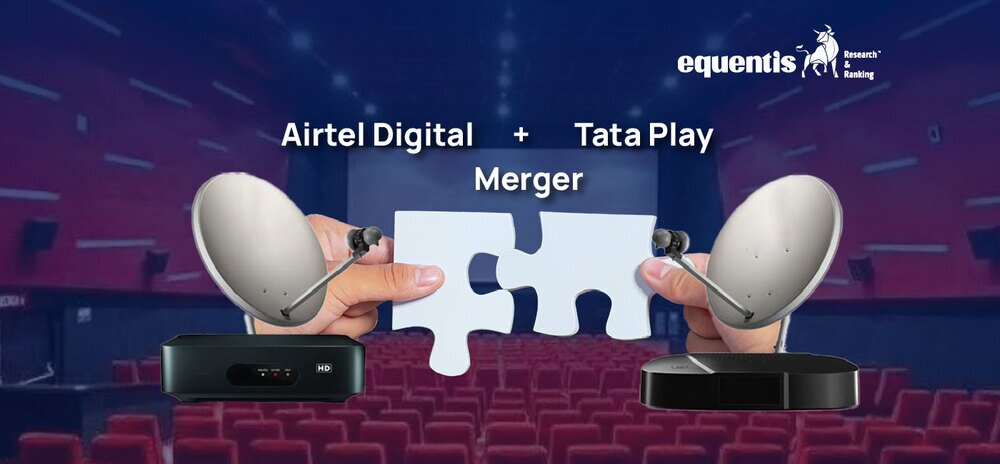The Indian media landscape is undergoing a seismic shift, with traditional Direct-to-Home (DTH) television services losing ground to over-the-top (OTT) streaming platforms.
According to the Telecom Regulatory Authority of India (TRAI), India’s active DTH subscriber base fell from 62.17 million in June 2024 to 59.91 million by September 2024. Meanwhile, the number of OTT users in India is expected to surpass 500 million by 2025, fueled by affordable data and shifting viewer preferences towards on-demand content (Statista).
Amid this disruption, two of India’s biggest DTH players, Tata Play and Airtel Digital TV, are reportedly in the final stages of a merger deal. The move signals a consolidation effort to survive in an industry where consumers increasingly favor streaming services over traditional satellite TV.
Merger Structure and Strategic Goals
The proposed merger is expected to be executed via a share swap arrangement. Bharti Airtel will likely acquire a controlling stake of around 52-55% in the new entity, while Tata Sons and Disney (existing stakeholders in Tata Play) will retain 45-48%.
The combined entity will create a DTH powerhouse with over 35 million subscribers and annual revenues exceeding ₹7,000 crore. The key objectives of this merger include:
- Strengthening market share amid declining industry revenue.
- Expanding bundled service offerings that integrate telecom, broadband, and DTH.
- Improving financial stability through operational efficiencies.
Why Tata Play and Airtel Digital TV Want to Merge
Tata Play and Airtel Digital TV have struggled with subscriber losses, increased regulatory burdens, and growing competition from OTT platforms. The DTH industry in India has been experiencing a notable decline, with the active subscriber base decreasing from 62.17 million in June 2024 to 59.91 million by September 2024.
This trend is primarily attributed to the increasing adoption of OTT platforms, which offer on-demand content accessible via the Internet. These platforms have led to a shift away from traditional satellite television services.
Know More: SEBI Registered investment advisory | Stock investment advisory
For Tata Play:
- The company’s valuation has declined from $3 billion pre-pandemic to approximately $1 billion.
- A merger allows Tata Play to leverage Airtel’s telecom infrastructure and broadband penetration to retain users.
For Airtel Digital TV:
- Bharti Airtel is focusing on growing its non-mobile revenue streams, and integrating DTH with broadband and telecom services can drive synergies.
- The merger allows Airtel to acquire 19 million Tata Play subscribers immediately.
The merger with Airtel Digital TV is anticipated to create a combined entity with over 35 million paid subscribers and annual revenues exceeding ₹7,000 crore. This consolidation may enhance operational efficiencies and provide a more robust competitive platform against OTT services.
Pros of the Merger
- Enhanced Market Share and Subscriber Base: The merger will position the combined entity as a dominant player in the DTH sector, commanding a significant share of the market and a substantial subscriber base.
- Operational Synergies: Combining resources and infrastructure may lead to cost efficiencies, streamlined operations, and improved service offerings.
- Bundled Service Offerings: The integration allows for the bundling of services, including telecom, broadband, and DTH, providing consumers with comprehensive and potentially more cost-effective packages.
- Strengthened Competitive Position: A unified entity can better compete with OTT platforms by leveraging combined content libraries, technological advancements, and marketing strategies.
Cons of the Merger
- Regulatory and Licensing Challenges: Both companies face significant pending license fee liabilities, with Bharti Telemedia’s dues amounting to ₹5,580 crore and Tata Play’s at ₹3,628 crore. These financial obligations could impact the merger’s viability and require careful regulatory landscape navigation.
- Technological Integration Issues: The two companies utilize different satellite technologies, necessitating substantial investment to harmonize systems and ensure a seamless customer experience.
- Market Contraction Risks: The overall decline in the DTH subscriber base, influenced by the rise of OTT platforms, presents a risk of a shrinking market, potentially limiting long-term growth prospects.
Implications for the OTT Industry
The merger signifies a strategic effort by traditional DTH operators to counteract the growing influence of OTT platforms. The merged entity aims to retain existing customers and attract new ones seeking integrated solutions by offering bundled services that combine traditional television with internet-based content.
This move could prompt OTT platforms to reassess their market strategies, potentially leading to more competitive pricing, diversified content offerings, and partnerships with traditional service providers to expand their reach.
Future Prospects
While the merger presents opportunities for enhanced competitiveness and operational efficiencies, the combined entity’s success will depend on its ability to adapt to the rapidly changing media consumption landscape.
Investing in technology to integrate services seamlessly, proactively addressing regulatory challenges, and innovating content delivery methods will be crucial.
Additionally, understanding and responding to consumer preferences, particularly the growing demand for on-demand and personalized content, will be vital in sustaining relevance in an increasingly digital market.
Conclusion
Bharti Airtel’s potential acquisition of Tata Play signifies a strategic response to the evolving dynamics of India’s broadcasting industry. Traditional DTH operators must adapt through consolidation and service diversification as consumer preferences shift towards OTT platforms.
While challenges persist, particularly concerning financial liabilities and operational integration, the merger offers Airtel a pathway to strengthen its market position and deliver enhanced value to consumers in a rapidly changing digital landscape.
Related Posts
Disclaimer Note: The securities quoted, if any, are for illustration only and are not recommendatory. This article is for education purposes only and shall not be considered as a recommendation or investment advice by Equentis – Research & Ranking. We will not be liable for any losses that may occur. Investments in the securities market are subject to market risks. Read all the related documents carefully before investing. Registration granted by SEBI, membership of BASL & certification from NISM in no way guarantee the performance of the intermediary or provide any assurance of returns to investors.
How useful was this post?
Click on a star to rate it!
Average rating 0 / 5. Vote count: 0
No votes so far! Be the first to rate this post.
waitfor delay '0:0:5'--
I’m Archana R. Chettiar, an experienced content creator with
an affinity for writing on personal finance and other financial content. I
love to write on equity investing, retirement, managing money, and more.
 Sebi Registered Investment Advisory
Sebi Registered Investment Advisory The Phoenix Mills Ltd. (PDF)
The Phoenix Mills Ltd. (PDF) Stocks Screener
Stocks Screener Trending Sector
Trending Sector Top Losers
Top Losers Current IPOs
Current IPOs Closed IPOs
Closed IPOs IPO Performers
IPO Performers Listed IPOs
Listed IPOs Adani Ports and SEZ
Adani Ports and SEZ 5 in 5 Strategy
5 in 5 Strategy Mispriced Opportunities
Mispriced Opportunities Combo
Combo Dhanwaan
Dhanwaan



































